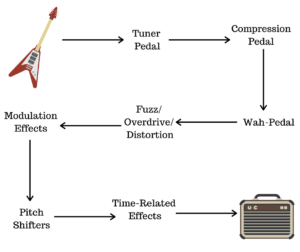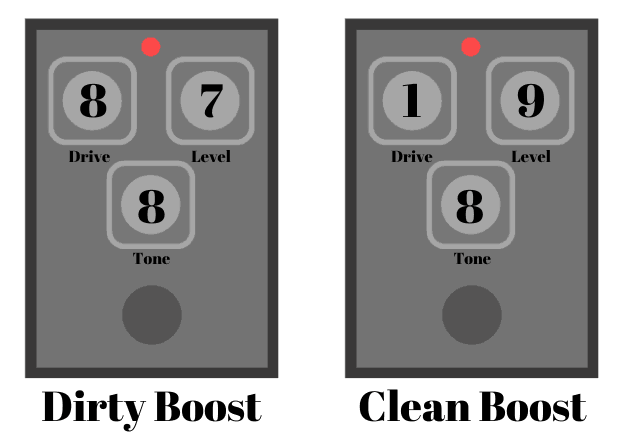Tube Screamer pedals are one of the most common types of overdrive pedal out there, and they have plenty of uses, in addition to just adding that gritty saturated tone it’s known well for.
One of those uses, is to act as a boost pedal. It’s a great idea if you already own an overdrive pedal and don’t want to pay for a boost pedal as well. Here’s a guide on how to do it properly to get the best results.
The Quick Answer
To use a tube screamer or overdrive pedal as a boost pedal, increase the level setting and the tone setting. You can also increase the drive setting to add more sustain and grit. Make sure the pedal is placed after any other distortion, fuzz or overdrive pedals in the pedal chain.
What does a Boost Pedal Do?
Before we jump into how to use the tube screamer as a boost pedal, it’s a good idea to get really clear on how a boost pedal actually works, and what result it has. Then you can properly understand how to use a tube screamer for this function.
Boost pedals up the signal produced by your amplifier. They can do this in different ways, mainly either by increasing the volume, or adding gain. They’re really useful if you need that extra kick for a solo, or certain part of a song, but need to back off in other parts. You can simply switch your boost pedal on to give you that extra signal increase, only at the times you need it.
It’s more effective than just altering the volume control on your electric guitar itself. This is because when you turn your guitar’s volume down, you can sometimes lose a lot of the gain and overall tone that you still need for rhythm sections of a song.
What does a Tube Screamer Do?
Tube Screamers are a category of overdrive pedals. These affect your tone a lot more than boost pedals do.
Overdrive pedals are used to mimic the sound of driving a tube amp hard enough so that it distorts the signal and causes it to break up. The result, is a crunchy, saturated tone.
It’s a bit different than a distortion pedal, as it’s less aggressive and works differently to give you a more gritty tone, compared to just adding pure gain.
Using the Tube Screamer as a Boost
Now you know what boost pedals and tube screamers are, and how they work, we can move onto how exactly you can use a tube screamer to act as a boost pedal. Here are 4 steps to keep in mind.
How to use a tube screamer as a boost pedal
- Set your amp and pedals up first
- Put the tube screamer after any distortion or overdrive pedals
- Adjust the controls on your tube screamer
- Then adjust your guitar’s controls
Here’s a detailed walk-through each of the these steps.
1. Set your Amp and Pedals up First
The first thing you should do, is set your amp and pedals up. Since your primary function of the tube screamer in this situation, is to boost the signal, you need to make sure your amp and pedals are set up first.
It really doesn’t matter how they’re set up, just as long as you’re happy with them. You want to set them up so they sound like the un-boosted section of the song you’re playing. It can be hard to focus on just these sections, but you need to rely on your tube screamer to take care of the boost function, and have everything sorted before you can add your overdrive pedal in.
Take a look at these posts to learn a bit more.
2. Put it After your Distortion or Overdrive Pedal
Now we need to talk about positioning. If you’re new to pedals, then you need to be aware that the position of your pedals will greatly affect the tone you achieve. So this step is pretty important.
Here’s how your pedal chain should usually look. Of course, you don’t need to have all these effects!

Your boost pedal should go in between your overdrive/ distortion pedal, and your modulation effects. This will allow you to use it as a proper boost pedal, rather than for gain. It’s still in a position where it can be fine tuned by other effects like modulation, pitch shifters and time-related effects as well.
Another alternative is to have it just before your amp. However, I’d usually recommend having it before any time-related effects. Give these positions a try and see which works best for your tone.
Looking to get the best out of your pedals? Check out my article on the best pedal chain order here to learn everything you need to know about setting up your chain.
3. Adjust the Tube Screamer Controls
Now everything is set up properly, you can move onto adjusting the controls on your actual tube screamer. Of course, the controls you can adjust, depends on what make and model overdrive pedal you are using. But generally you’ll be able to control the level, drive and tone. Here’s what they mean.
- Drive: this refers to the amount of gain.
- Level: this refers to the volume of the pedal.
- Tone: this refers to the amount of bass, mids and treble frequencies.
If you want a heavy overdriven tone when you kick in the tube screamer, then have your drive fairly high. But if not, then turn it right down for a cleaner tone.
You can adjust the level control, depending on how much of a boost you actually need. If you need a big volume increase, then of course you should crank this right up. But if you want a more subtle boost, then don’t turn it up as high.
Finally, the level of the tone control really depends on what sound you’re after. However, I would say that if you’re using the boost pedal for the most common reason, to make your guitar stand out amongst the other instruments, then you’ll want a sharper sound. This means, you’ll want to favour treble frequencies. It’ll allow you to cut through the mix a bit more than if you focused on bass frequencies.
4. Adjust your Guitar's Controls
Finally, you should adjust your guitar’s controls, like the pickup selector, volume control and tone control. This is the last thing you should do, because any adjustments made here will be pretty minor.
When it comes to the pickup selector, I’d recommend using the bridge pickup, if you want your guitar to cut through the mix for example, when playing a solo. It’ll give you the sharpest sound and provides more clarity.
I’d always recommend having the volume control on your guitar on maximum. If you turn it down, the effect of the pedals tends to shine through less, which kind of defeats the point of using a boost pedal at all.
The adjustment of the tone control is less clear cut. It really depends on what kind of tone you’re after. But generally, you should have it on high, because it’ll give you a sharper sound, and like using the neck pickup, it gives you the ability to cut through the rest of your band a bit more.
Clean vs. Dirty Boosting
One thing I’d like to touch on before the end of this post, is the difference between a clean boost and a dirty boost.
Clean boosting is when you only really get a volume increase, as opposed to any gain. Dirty boosting on the other hand, gives you gain as well as volume.
When it comes to using your tube screamer as a boost pedal, it should come as no surprise that it works much better as a dirty boost, because it’s built to create an overdriven effect. You can adjust the drive control up to increase the amount of gain and hence the “dirtiness” of the boost.
However, you can still use it to get a cleaner boost. You’ll need to turn the drive as low as you can have it, without losing the pedal’s affect completely. Then you should have the level as high as possible. This will give you the cleanest sounding boost when using a tube screamer or other overdrive pedal.

Organising your new pedalboard? Check out my ultimate guide to designing a pedalboard including all the equipment you need and a step by step formula to getting set up in a pain-free way.
So there you go! That’s how to use an overdrive pedal like the Tube Screamer as a boost pedal! I hope you’ve found this article helpful, thanks for reading. Here are some other posts you might find useful:
